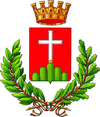Potenza Picena
| Potenza Picena | ||
|---|---|---|
| Comune | ||
| Comune di Potenza Picena | ||
 | ||
| ||
 Potenza Picena Location of Potenza Picena in Italy | ||
| Coordinates: 43°22′N 13°37′E / 43.367°N 13.617°E | ||
| Country | Italy | |
| Region | Marche | |
| Province / Metropolitan city | Macerata (MC) | |
| Frazioni | Montecanepino, Porto Potenza Picena, San Girio | |
| Government | ||
| • Mayor | Sergio Paolucci (Partito Democratico) | |
| Area | ||
| • Total | 47.6 km2 (18.4 sq mi) | |
| Elevation | 237 m (778 ft) | |
| Population (31 December 2010)[1] | ||
| • Total | 16,081 | |
| • Density | 340/km2 (870/sq mi) | |
| Demonym(s) | Potentini, Santesi | |
| Time zone | CET (UTC+1) | |
| • Summer (DST) | CEST (UTC+2) | |
| Postal code | 62018 | |
| Dialing code | 0733 | |
| Patron saint | St. Stephen, St. Girio, St. Anna (Porto) | |
| Saint day |
May 25 (St. Giro) December 26 (St. Stephen) (July 26 for Porto) | |
| Website | Official website | |
Potenza Picena is a comune (municipality) in the Province of Macerata in the Italian region of Marche, located about 30 kilometres (19 mi) southeast of Ancona and about 15 kilometres (9 mi) northeast of Macerata.
Potentia was the Roman town situated in the lower Potenza valley, in the contemporary Italian region of Marche.
Geography
The town is upon a hill few kilometres from the Adriatic coast. The bordering municipalities are Civitanova Marche, Montecosaro, Montelupone, Porto Recanati and Recanati.
The now abandoned Roman town Potentia was located along the central Adriatic Italian coast, near the modern town of Porto Recanati, in the province of Macerata. Its original position was just north of the main Roman bed of the River Potenza (the ancient Flosis), which at present flows more than 1 km to the north.
Late Roman Potentia
The general agreement that in Italy the late and post-Roman period saw a widespread and marked decline in town dwelling, with various Roman centres progressively abandoned and those that survived were less populous and certainly less monumental than before, also applies for Potentia. Due to surviving literary sources it is known that Potentia became an episcopal seat by the beginning of the 5th century and that a bishop was present in Potentia up to the beginning of the 6th century. Although archaeological studies still have to prove the existence of a new Christian sanctuary it should be assumed that a church was built around 400. From the 4th century onwards city occupation gradually contracted. The finding of later 5th and/or 6th century graves in the northern part of the town implies that the city wall no longer defined a deliberate and real limit to the town. From the 6th century onwards the former urban center was gradually abandoned and dismantled, at the profit of the nearby new towns of Recanati, Potenza Picena and later Porto Recanati.
Geography
Modern Potenza counts three frazioni: Montecanepino, Porto Potenza Picena and San Girio.
Buildings
- San Francesco.
- Sant'Agostino.
- Santuario di San Girio.
- Chiesa degli Zoccolanti.
- Chiesa dei Cappuccini.
People related to Potenza Picena
- Renzo Tortelli, photographer.
- Giordano Macellari, painter.
Contemporary twin towns
References
External links
![]() Media related to Potenza Picena at Wikimedia Commons
Media related to Potenza Picena at Wikimedia Commons
